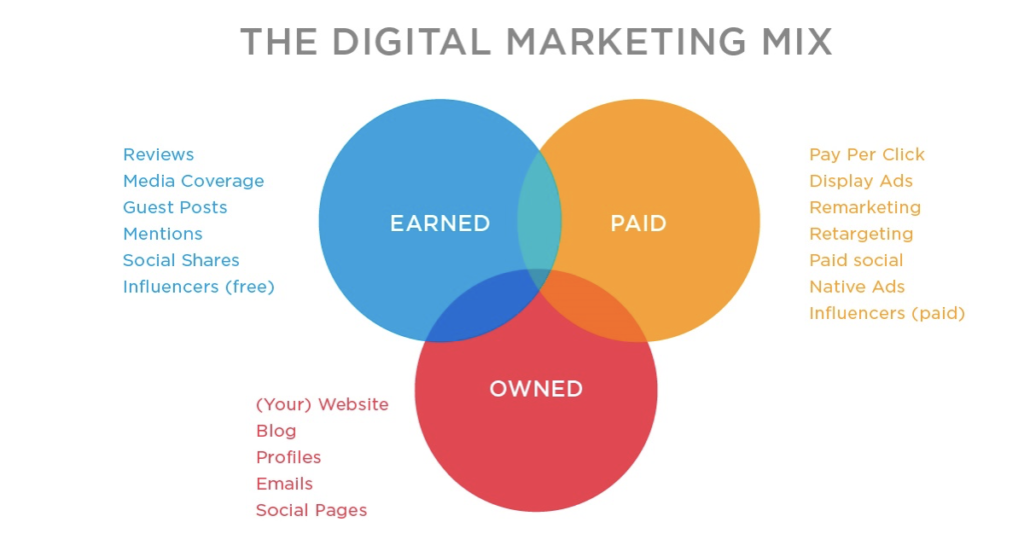Table of Contents
Businesses often require various media marketing strategies in order to reach their audience and build their brand. However, it’s difficult to know where to start and what strategy is best. Three prominent strategies that many companies utilize are earned, owned, and paid media — all of which serve various functions and can reach different audiences depending on your goals.
3 Types of Media
Paid media is about advertising and revolves around the idea that you’re trading your money to market your company.
- Sponsored posts on Instagram
- Well-designed banner ads with banner templates for websites
- Influencer campaigns
Earned media is about publicity. Any type of organic attention centered around your company all helps with brand awareness in a manner that often feels more genuine than paid media tactics.
- Media coverage (print, TV, etc.)
- Mentions on social media posts
- Reviews
Owned media is about branding that you have direct control over. Therefore, the more owned media a company or brand has, the more potential there is to attract its target audience.
- Blog
- Website
- Social media accounts
- Emails
- Newsletters
- Podcasts

Paid Media
Each media type has its unique benefits and disadvantages. For example, if your business is focusing on generating sales and traffic, then paid media is the name of the game. Targeted ads like the one below have been a popular avenue for numerous companies and have been proven to drive impressions and sales.
With the likes of Facebook and Instagram being incredibly accessible to the masses, it’s no surprise that brands are flocking to various social media platforms to advertise their brand. The fact that Facebook made over 28 billion dollars in ad revenue in the second quarter of 2021 speaks for itself. Paid media works.
Here’s an example of a company using a banner ad to drive downloads to their e-book.

Source: Tech Crunch
Another example of paid media is sponsoring an influencer’s content. You can see this strategy with many famous YouTubers such as David Dobrik, Logan Paul, and Jeffree Star. Here, companies reach out to such individuals to get a shoutout or a short promotion of their company/product in the influencer’s video.
One case to examine is David Dobrik’s partnership with SeatGeek, a mobile-focused ticket platform and search engine that lets fans buy and sell tickets for various events.
🚨 TESLA GIVE AWAY 🚨
Because what else would @DavidDobrik and the app that helps you buy tickets in literally the easies way possible….give away for the holidays😉
👇 David’s IG to enter 👇https://t.co/EDuMJPy08s pic.twitter.com/fQCEHGFzAm
— SeatGeek (@SeatGeek) December 21, 2019
With Dobrik having amassed over 18 million subscribers on YouTube, SeatGeek has spent millions of dollars sponsoring his content. Whether that’s providing Dobrik with over a dozen luxury vehicles to gift to his friends and fans or tickets to huge events like the Superbowl, the results speak for themselves.
In exchange for 20-second shoutouts with Dobrik and other influencers, SeatGeak’s sales have grown by over 1,500% since 2015. Thus, demonstrating that influencers are a powerful asset to have. Other companies have identified the power of influencers and utilized paid media. Today, big named businesses such as Sony, Pepsi, Dunkin’ Donuts, and Hertz are constantly partnering with influencers to promote their products.
Shoutouts are more lucrative than you think. Check out this blog to see how celebrities and influencers are getting paid to send shoutouts with Cameo.
Owned Media
Perhaps you don’t have the budget to invest in a paid media strategy or your business isn’t focused on immediate calls to action, then owned media may be best.
Establishing consistent, quality content via social media, blogs, etc. positions you as an expert and leader in your field. This helps drive organic sales and builds branding. While this requires dedication and commitment through long durations of time, this is an effective strategy many businesses have used.
Nike is a prime example of using social media to not just sell their products, but to tell stories that inspire and captivate their audience.
View this post on Instagram
Nike also utilizes influencers in its owned media strategy. In the graphic above, Nike leverages NBA athletes to promote their shoes. NBA stars, like Lebron James and Giannis, are at the pinnacle of the basketball world and have captivated millions. These stars have an aura of stardom and mystique that inspires many to mimic and follow their every action.
Nike, just as a brand, cannot generate the same level of fandom as these stars. So, they partner with these athletes. These collaborations drive millions, if not billions of dollars, in sales for Nike by combining great shoe design and functionality with the brand of these athletes.
Looking to run an epic influencer marketing campaign like these? NeoReach has the best experience in creating viral campaigns that convert on social media. Sign up here!
Earned Media
Unlike the other two strategies, earned media is more difficult to implement because, by definition, earned media is “earned.” If owned media revolves around the effort you put in to produce quality content, then earned media highlights the importance of people seeing it. Revolving around online word of mouth, earned media is an effective way of building credibility in your targeted audience that fosters and establishes your brand as reliable and more likely to be trusted by customers.
In a study conducted by HubSpot Research, results found that 57% of adults in the United States trust recommendations made by their family and friends. Thus, earned media — while more difficult in some regards — is still incredibly effective.
Thus, it’s not uncommon for brands to highlight product reviews made by customers. Private Paradise, an online retailer specializing in products catered toward the K-Pop sensation BTS, is one such example.
For new potential customers interested in buying from this merchant, being able to see highly ranked reviews from a variety of past purchasers bolsters the credibility and the likelihood that they would purchase from Private Paradise. Additionally, with social media being one of today’s biggest channels for earned media to occur, it’s not uncommon for brands who are trying to build a better reputation and stake in the market to be re-blogging any mentions that have reviews or comments regarding their products
Again, taking Private Paradise as another example, it should be highlighted that earned media is continuously doing as much as possible to attract new customers and generate profits. The fact that this retailer is both including reviews and reposting on social media demonstrates how earned media is a non-stop, active effort. It’s gathering this momentum that helps build a foundation for your branding.
Running active, relevant social media accounts is no longer a marginal job. Read more about creating brand accounts benefit you here.
Even for big brand companies who have already established themselves in the market, the value of earned media doesn’t decrease. Microsoft, one of today’s biggest technology corporations, continues to attract media coverage in major publications because they constantly are at the forefront of innovation.
What earned media also implies is that your brand or company must be newsworthy and interesting enough for individuals to deem that your product is deserving of taking the time to spread coverage. Stagnancy in such attention and engagement with your audience, no matter how big your brand is, often fails to lead to a positive outcome.
While this article only scratches the surface by providing an overview into paid, earned, and owned media, the message remains the same. If done well, these three marketing strategies are incredibly effective at transforming your business by improving brand, credibility, sales, website traffic, and more.
























